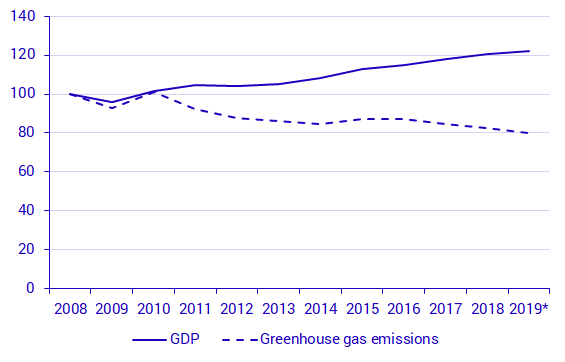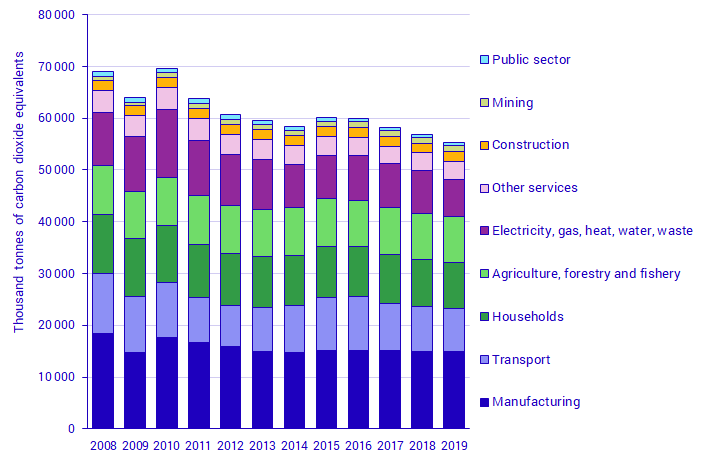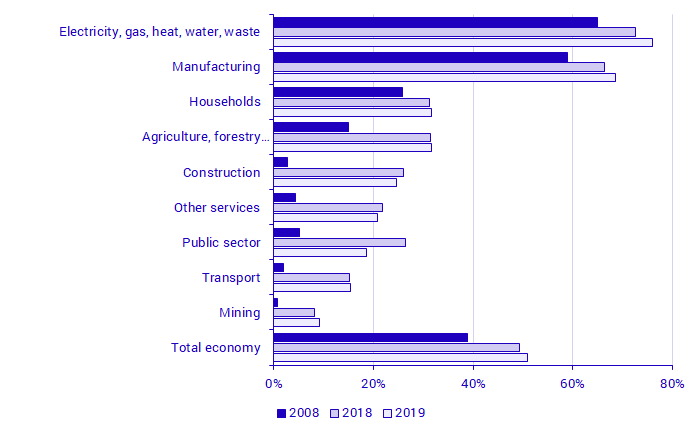Environmental accounts – Emissions to air 2019
Greenhouse gas emissions from Swedish economy continued to decline in 2019
Statistical news from Statistics Sweden 2021-03-25 9.30
Greenhouse gas emissions from the Swedish economy and households amounted to 55.3 million tonnes of carbon dioxide equivalents in 2019. This corresponds to a decrease of 2.8 percent compared with 2018. Between 2008 and 2019, greenhouse gas emissions decreased by about 20 percent. GDP increased by 22 percent over the same period.
Greenhouse gas emissions followed the economic trend between 2008 and 2010. Between 2010 and 2014, greenhouse gas emissions decreased by 16 percent, while GDP grew by 7 percent. Between 2014 and 2019, greenhouse gas emissions have decreased by 4 percent, while GDP grew by 14 percent over the same period.

*2019 GDP in fixed prices are preliminary. Source: Statistics Sweden, Environmental accounts and National accounts
Emissions from the energy and utilities sector decreased
Greenhouse gas emissions from electricity, gas, district heating and water supply decreased by 17 percent in 2019 compared with 2018. Fossil fuel use in this sector decreased, subsequently the level of greenhouse gas emissions also dropped. Greenhouse gas emissions from the transport industry and households decreased by 4 and 3 percent respectively.
The manufacturing industry accounted for over a quarter of total greenhouse gas emissions from the Swedish economy in 2019, which is unchanged from 2018. Emissions from steel and metal production increased, while they decreased from petroleum refineries.

Source: Statistics Sweden, Environmental accounts.
Proportion of biofuel combustion increased
The proportion of biofuels, that is, biofuel use in relation to total fuel use (fossil and biogenic) in the Swedish economy has increased from 39 percent in 2008 to 51 percent in 2019. This is due to an increase in the amount of biofuels and a decrease in the amount of fossil fuels over the period. Between 2018 and 2019 the proportion of biofuels increased by 2 percent.
The proportion of biofuels is largest in the electricity, gas and district heating and manufacturing industries. These industries also account for the largest use of biofuels overall. The proportion of biofuels in these industries also increased between 2018 and 2019. The proportion of biofuels decreased in the public sector during the same period.

Source: Statistics Sweden, Environmental accounts
Environmental economic profiles updates later in the year
The Environmental Accounts also presents industries’ emissions in relation to employment and value added (industry’s contribution to GDP). However, the air emissions statistics are prepared and published before the annual employment and value added statistics. Therefore, emissions intensities and environmental-economic profiles will be updated later in the year, when this data becomes available for 2019.
Use the analytical tool for environmental economic data
Environmental accounts data is available via an analytical tool online that combines data from the Environmental Accounts and economic data. This tool can be used to explore emissions statistics from both production and consumption perspectives along with other environmental economic data. The tool is available on the Environmental Accounts’ data and analysis pages. Using the tool, you can generate your own indicators, compare environmental pressures from different industries and study the relationship between demand in the economy, energy use, and emissions.
Definitions and explanations
The Environmental Accounts present national environmental statistics and economic statistics in a common framework using NACE industry classification. This makes it possible to analyse the relationship between the economy and the environment. The starting point for the Environmental Accounts is the environmental impact of Swedish economic actors, regardless of where in the world their emissions occur.
These statistics on emissions to air are based on a production perspective. Emissions are reported by industry in which the emissions occur, including households’ direct emissions (i.e. combustion of fossil fuels, heating and other direct emissions). Indirect emissions from imports and other consumption of goods and services are not included.
Statistics on emissions to air published by the Swedish Environmental Protection Agency follow the UNFCCC framework and cover emissions within Sweden’s territorial borders. Sectors are disaggregated by emissions category (process), rather than by industry. Emissions and removals from land use and land use change are included, while emissions from international aviation and navigation are reported separately. See also:
Klimatutsläpp (in Swedish)
Revisions
A number of revisions have been introduced since the previous publication.
Revisions have been implemented on 2018 activity data for shipping companies, which resulted in a sharp decrease of emissions.
Furthermore, some emission factors were changed and resulted in minor changes in data over time.
A new data collection on energy use in small enterprises in manufacturing industries was introduced for reference year 2019, which affected data between 2008 and 2018.
A general increase or decrease of emissions cannot be derived from these revisions and has only led to minor changes.
More information on these updates are available via the link below, under the heading Documentation:
Miljöräkenskaper (in Swedish)
Next publishing will be
The next item of statistical news on quarterly emissions to air will concern the fourth quarter of 2020 and will be published on 2021-05-12 at 09.30. Preliminary statistics on 2020 will also be published at this time.
The next statistical news on annual emissions to air, 2008-2020 (final statistics) is scheduled for publication in early 2022.
Statistical Database
More information is available in the Statistical Database
Feel free to use the facts from this statistical news but remember to state Source: Statistics Sweden.
